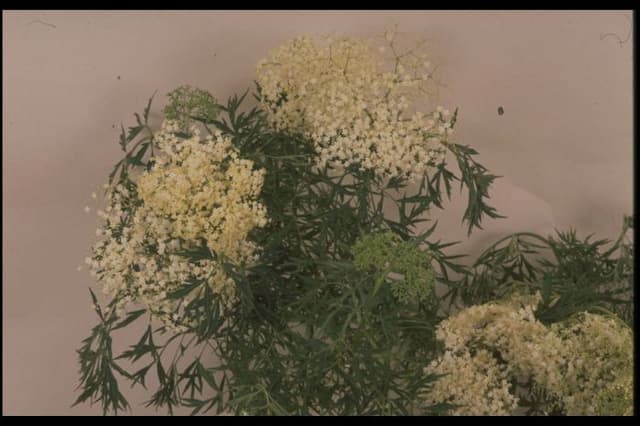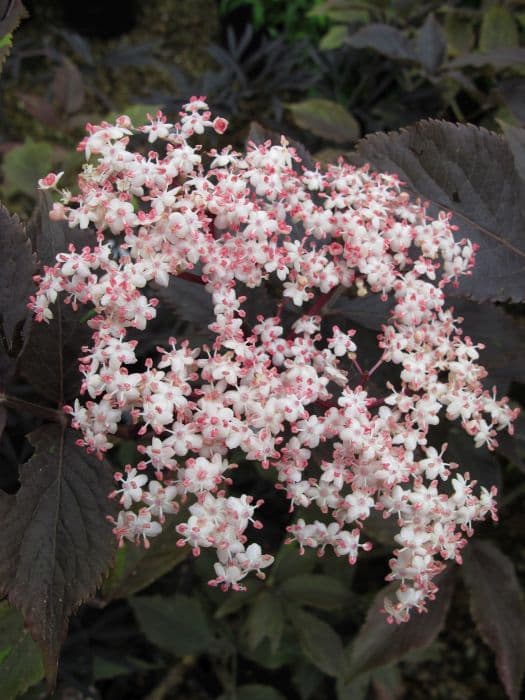Doublefile Viburnum Viburnum plicatum f. plicatum

ABOUT
The common name of Viburnum plicatum f. plicatum is Doublefile Viburnum. This plant is known for its beautiful, showy appearance with distinctive layered branches that create a tiered look, which is where the name Doublefile derives from, as the flowers line up in rows along the branches. The leaves are dark green, oval-shaped with pointed tips, and have a pleated, textured surface, giving the plant a somewhat ruffled appearance. In springtime, the Doublefile Viburnum becomes a focal point in the landscape thanks to its abundance of large, lacecap-style flowers. The blooms are primarily white and are arranged in a flat-topped, circular pattern, which makes them very attractive to both humans and pollinators alike. As the season progresses, the flowers may be replaced by red berries that mature to black, offering a visual treat to birds and other wildlife. In autumn, the foliage often transforms into a stunning display of reddish-purple hues, rounding out the visual interest that this plant provides throughout the year.
About this plant
 Names
NamesFamily
Adoxaceae
Synonyms
Japanese Snowball, Doublefile Viburnum, Japanese Snowball Bush
Common names
Viburnum plicatum var. plicatum, Viburnum tomentosum Thunb.
 Toxicity
ToxicityTo humans
Japanese Snowball (Viburnum plicatum f. plicatum) is not considered highly toxic to humans. Ingesting parts of the plant may cause mild stomach upset in some individuals, but severe poisoning is rare. Symptoms might include nausea, vomiting, and diarrhea if consumed in large quantities. Although it's not particularly dangerous, it is still advisable to avoid eating any part of the plant.
To pets
Japanese Snowball is considered to have a low level of toxicity to pets. If pets consume parts of this plant, they might experience mild gastrointestinal upset such as vomiting or diarrhea. It is not known to cause serious illness or fatalities in pets, but it is still best to prevent pets from ingesting it to avoid potential discomfort.
 Characteristics
CharacteristicsLife cycle
Perennials
Foliage type
Deciduous
Color of leaves
Green
Flower color
White
Height
8-10 feet (2.4-3 meters)
Spread
6-8 feet (1.8-2.4 meters)
Plant type
Shrub
Hardiness zones
5
Native area
Japan China
Benefits
 General Benefits
General Benefits- Ornamental Value: Japanese snowball Viburnum's showy, white, ball-shaped flowers and layered branches add aesthetic beauty to gardens.
- Wildlife Attraction: The plant provides food in the form of berries and flowers and shelter for various birds and insects.
- Shade Tolerance: It can grow well in partial shade, offering flexibility in landscaping designs.
- Seasonal Interest: Features vivid fall foliage colors and persistent winter berries that enhance the visual interest throughout seasons.
- Erosion Control: Its dense root system can help in stabilizing soil and preventing erosion.
- Privacy Screen: Can be used as a dense hedge or screen to provide privacy due to its thick foliage.
- Low Maintenance: The plant is generally low-maintenance, requiring minimal pruning and care once established.
- Drought Resistance: Once established, it shows a reasonable degree of drought tolerance, making it suitable for drier climates.
 Medical Properties
Medical PropertiesThis plant is not used for medical purposes.
 Air-purifying Qualities
Air-purifying QualitiesThis plant is not specifically known for air purifying qualities.
 Other Uses
Other Uses- Create a natural dye: The leaves and bark of the Doublefile Viburnum can be used to make a range of natural dyes for textiles, providing hues from green to brown depending on the mordant used.
- Insect-repelling properties: The plant can be included in gardens to naturally repel certain insect pests, as some Viburnum species contain compounds that are unattractive to bugs.
- Photography backdrop: Owing to its striking symmetrical blooms, Doublefile Viburnum serves as an excellent backdrop for photographers, especially when capturing springtime themes.
- Sound barrier: This plant can be grown in dense hedges which help reduce noise pollution from roads and neighbors when planted as a buffer zone.
- Windbreak: In landscapes, the sturdy branches and thick foliage can be used to form a windbreak to protect sensitive plants and reduce soil erosion.
- Educational tool: The distinct appearance of leaves and their arrangement provides a unique educational opportunity for botany students to learn about plant morphology and taxonomy.
- Frost protector: When planted strategically, the dense foliage can help to shelter tender plants from early morning frost.
- Privacy screen: The lush growth of Doublefile Viburnum provides a natural privacy screen for home gardens or as a visual barrier between different areas within larger landscapes.
- Craft material: The woody stems and branches can be used for making small handcrafted items or for rustic decorating elements in floral arrangements.
- Leaf pressing: The attractive leaves of Doublefile Viburnum can be used for leaf pressing, a simple and classic method for creating botanical art or for use in crafts.
Interesting Facts
 Feng Shui
Feng ShuiThe Japanese Snowball is not used in Feng Shui practice.
 Zodiac Sign Compitability
Zodiac Sign CompitabilityThe Japanese Snowball is not used in astrology practice.
 Plant Symbolism
Plant Symbolism- Renewal and New Beginnings: The Doublefile Viburnum is known for its beautiful spring blossoms, signifying rebirth and the start of new phases.
- Perseverance: Doublefile Viburnum is a hardy shrub that can withstand various conditions, symbolizing the ability to persist through challenges.
- Purity and Innocence: The white flowers of the Doublefile Viburnum are often associated with purity and innocence due to their color and delicate nature.
- Abundance: With its plentiful clusters of flowers and later, berries, the Doublefile Viburnum represents abundance and the generous giving of nature.
- Protection: As a robust shrub, the Doublefile Viburnum can provide shelter for wildlife, denoting protection and safety.
 Water
WaterJapanese Snowball (Viburnum plicatum f. plicatum) should be watered deeply to ensure moisturization of the root zone, usually requiring about 1 inch of water per week. During hot or dry periods, this may need to be increased to keep the soil consistently moist but not waterlogged, roughly translating to about 2-3 gallons for a young plant and up to 10 gallons for a mature shrub once a week. In fall and winter, reduce watering as the plant requires less moisture. It's best to water early in the morning to reduce evaporation and prevent fungal growth on the leaves which can occur if they remain wet overnight.
 Light
LightJapanese Snowball thrives in full sun to partial shade, meaning it prefers at least 6 hours of direct sunlight a day but can tolerate some afternoon shade. The plant will flower most abundantly in full sun, so ideally place it where it can receive unfiltered sunlight throughout the morning with some protection from the intense sun in the late afternoon.
 Temperature
TemperatureJapanese Snowball can survive in temperatures as low as 0°F but is happiest in the range of 60°F to 75°F. The plant is quite hardy and can tolerate a range of conditions, but prolonged exposure to temperatures above 90°F or below 0°F can stress the plant.
 Pruning
PruningPruning the Japanese Snowball is essential for maintaining shape and encouraging blooming. It's best to prune right after the shrub finishes flowering, usually in late spring or early summer, to avoid cutting off next year's buds. Thin out old and crowded branches and remove any dead or diseased wood. Generally, this plant requires light pruning once a year.
 Cleaning
CleaningAs needed
 Soil
SoilThe Japanese Snowball needs well-draining soil with a pH between 5.5 to 6.5. A mix consisting of loamy garden soil, peat moss, and perlite or sand in equal parts creates the ideal growing medium for this plant.
 Repotting
RepottingThe Japanese Snowball does not require frequent repotting; it should generally be repotted every 3-5 years or when it becomes pot-bound and the growth appears to be stunted.
 Humidity & Misting
Humidity & MistingJapanese Snowball prefers moderate humidity levels but is quite adaptable to different humidity conditions, making it well-suited for typical outdoor environments.
 Suitable locations
Suitable locationsIndoor
Place Japanese Snowball in bright, indirect light indoors.
Outdoor
Plant in partially shaded area; water regularly, and mulch the base.
Hardiness zone
5-8 USDA
 Life cycle
Life cycleThe life of Viburnum plicatum f. plicatum, commonly known as Japanese Snowball, begins with germination, where the seed, after stratification, sprouts and develops a root system and a shoot. This is followed by the vegetative growth stage, where the plant develops a woody structure, leaves, and a branching habit characteristic of the species. As it matures, the Japanese Snowball enters the flowering stage, typically in spring, producing large, showy, white sterile flowers that are appealing to pollinators and gardeners alike. After pollination by insects, the flowers develop into small red berries, which later mature to black, and these fruits contribute to the reproductive stage by distributing seeds for new plant growth. The plant then goes through an annual cycle of dormancy in the winter, losing its leaves and conserving energy. As perennial shrub, the Japanese Snowball repeats this growth cycle for many years, with proper conditions and care allowing it to thrive and rejuvenate each spring.
 Propogation
PropogationPropogation time
Early Spring
The most popular method for propagating the Japanese Snowball (Viburnum plicatum f. plicatum) is through softwood cuttings, which is usually done in late spring or early summer when the new growth is just beginning to harden. To propagate, select a healthy stem with several leaves, and cut a 4 to 6-inch (approximately 10 to 15 cm) piece, ideally with a few nodes present. The leafy end should be dipped in rooting hormone powder or gel to encourage root development. Then, the cutting is inserted into a well-draining soil mix, ensuring that at least one node is beneath the surface, as this is where the roots will emerge from. The pot or tray with the cuttings should be kept moist and in a warm area with indirect sunlight until roots have developed, which may take a few weeks. Once the cuttings have rooted and begun to grow, they can be transplanted to their permanent location.









